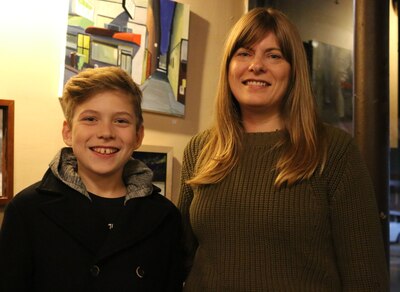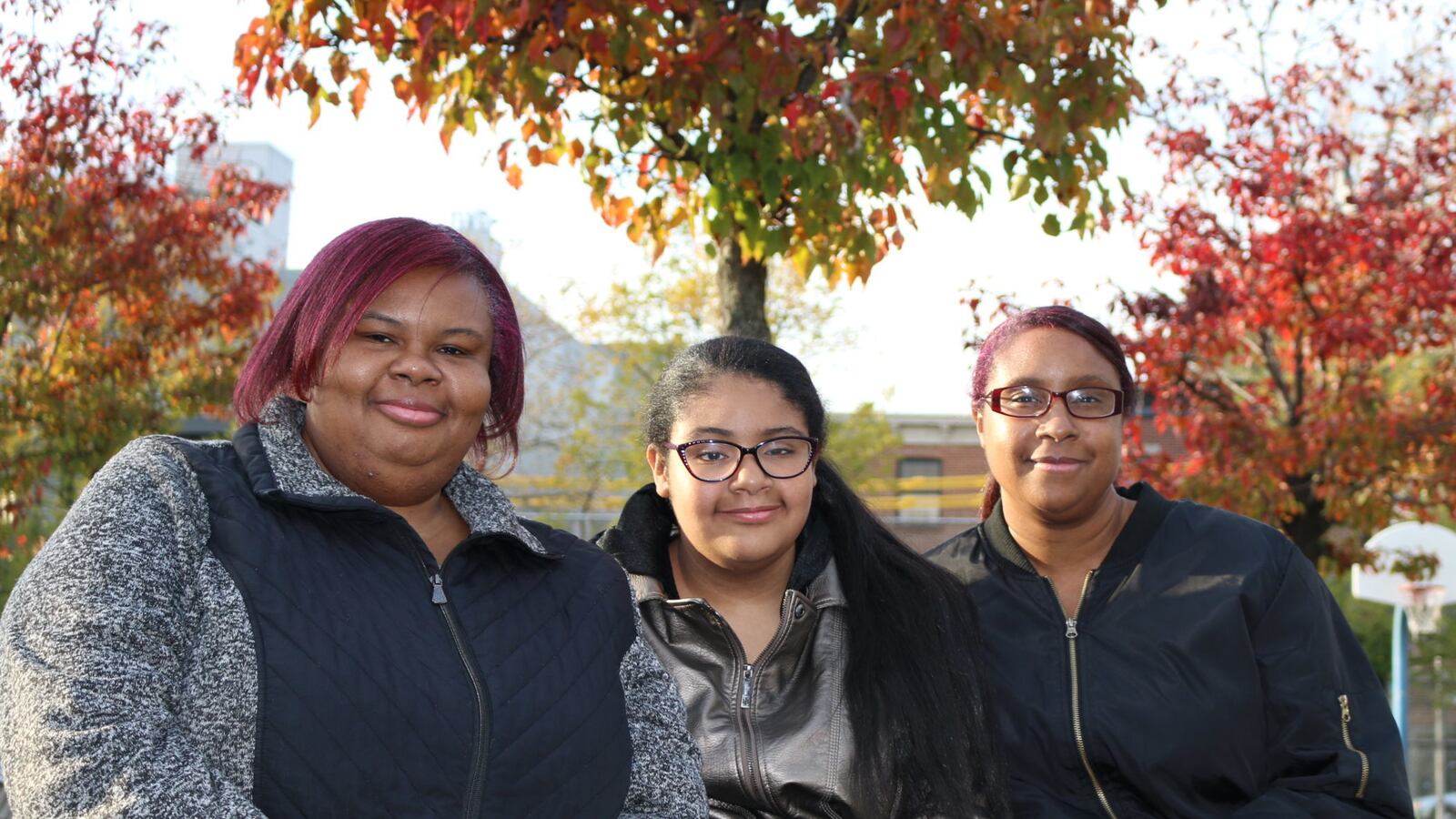In the mornings, the B61 city bus in Brooklyn feels like a school bus, filled with students criss-crossing District 15.
Sixth-grader Melina Mays climbs aboard in Red Hook, along with her neighbors and friends. Many peel off along the way, heading towards schools that have been considered the district’s most coveted, like Park Slope’s M.S. 51 and South Slope’s New Voices. But 11-year-old Melina continues on, catching a second bus that drops her off at Sunset Park Prep, about an hour away from home by public transit.
Melina doesn’t care that Sunset Park Prep isn’t one of the schools with an outsized reputation. She put it first on her list of options after meeting friendly, inviting students and teachers when touring the school.
“I think a lot of families want something that’s very close to them, and very well-known so they can kind of brag a little bit. So they can say, ‘Oh my child goes to this well-known school that is, like, one of the best schools in the community,’” Melina said.
This year’s sixth graders were the first to enter middle school as part of a new admissions plan to integrate schools in District 15, which includes affluent and mostly white Brownstone Brooklyn neighborhoods, such as Cobble Hill and Park Slope, as well as areas with higher poverty and a significant Hispanic population, such as Red Hook and Sunset Park.
The district’s first year of enrollment data show that schools are already becoming more integrated. We spoke to four students and their families at a pair of schools that are starting to get more attention from families that hadn’t previously considered them as options: Sunset Park Prep and the South Slope’s M.S. 88, which have historically served mostly Hispanic students from low-income families.
Now, some of those families are going back to their previous elementary schools and sharing their impressions of this first year. Along the way, they’re helping to shape their neighbors’ perceptions about the district’s options before middle school applications are due on Dec. 6.
Their feedback could help boost the district’s diversity push, which rests largely on families overcoming fears of the unknown, going to schools they may have never heard of or in neighborhoods where they seldom spend time.
At Melina’s Red Hook elementary school, P.S. 15, officials organized tours for families to explore their options. Her mother, Dorothy Mays, hadn’t even heard of Sunset Park Prep prior to applying. The Mays family is black, and last year there were only about 10 black students at the school. Mays had instead hoped for the places where families often clamor for admission and felt the diversity plan could increase her daughter’s odds of getting in. As part of the plan, the entire district eliminated competitive admissions criteria that most of the area’s 11 middle schools had used. Instead schools are now assigned students by lottery, with priority given to certain disadvantaged families.
“Last year, it became, you could pick a school you really wanted, and know you had a shot,” Mays said. “It was an eye opening experience to see some schools and the different programs they offered.”
What sold Dorothy Mays on Sunset Park Prep was that the principal seemed to know all her students by name, and the students who helped lead tours said they felt understood and respected by their teachers. The commute now seems worth it, even after a promised school bus fell through. Mays has turned into an evangelist, downplaying the distance to her neighbors.
“We didn’t know anyone from our neighborhood actually went there,” Mays said. “So we’ve been trying to tell people, ‘This is a great school. Go.’”
Melina said she loves gym class, but sometimes has trouble keeping up in math.
“In P.S. 15, we didn’t learn everything that we’re doing. So my math teacher, she will start doing something, and I don’t know anything,” said Melina, who gets math help at home from an aunt to keep up.
Owen McNamara has had a different experience at Sunset Park Prep. He said his classes are sometimes easy because they can feel like a review of what he learned in fifth grade at P.S. 321. The school’s principal, Jennifer Spalding, said that is partly by design: The first few weeks of school are spent getting to know students and reviewing key concepts from elementary school.
When Owen found out he had been accepted to Sunset Park Prep, he worried about not knowing anyone: Only one other student from his elementary school would be heading there.
He and his family paid a visit, and Claire McNamara, Owen’s mom, remembers teachers in the hallway made a point to greet them. They decided the school was a good option, even though McNamara had previously hoped Owen would get accepted to a school with a music program and was close to home, such as M.S. 51, which is just a short walk away.

Now that the 11-year-old would have to commute by city bus and subway, the family reluctantly bought him a cell phone — a flip phone without an internet connection. Owen remembers gripping the hand rails on his first solo bus ride. That initial nervousness has worn off, and now he said he finds the commute “relaxing.” He isn’t worried about being alone anymore, either, having made friends on the very first day of school. For the first time, they include students who are still learning to speak English.
“I think it makes it kind of better, because you get to learn a lot more about everyone else and everyone else’s culture,” said Owen, who is white. “And it’s a good opportunity to learn more about different races that aren’t yours.”
There are notable differences from his elementary school experience. Owen played trumpet there, but hasn’t had the same opportunity at Sunset Park Prep. His mom said it’s sometimes hard to stay informed about how she and other parents can pitch in, especially compared with the well-oiled PTA at their elementary school.
While Sunset Park Prep, where more than 90% of students come from low income homes, might not be able to raise much money from families, it is a powerhouse when it comes to participatory budgeting — a voting process that lets the community decide how to spend city money on public projects. One of Owen’s favorite classes is science, where students are using triple beam balances and other equipment in a lab that was redone thanks to almost $2 million in participatory budgeting projects that have been funded in recent years.
Sunset Park Prep enrolled virtually no white students last year, but this year white students make up 10% of the sixth-grade class.
McNamara was reassured at the first parent-teacher conferences that Owen’s teachers already seemed to know him well. She was planning to head back to P.S. 321 to share her impressions at an event for fifth grade families, saying it’s the first time anyone can remember someone representing Sunset Park Prep at the event.
“It’s great the way it is, but I think it’d be great if people from all over the district knew about it,” she said. “It wasn’t really on my radar, and I’m really glad we ended up there.”
Becket Tavenner and his mom, Mimi Turner, logged into the education department’s portal one day last spring to find out where he had been accepted to middle school. Both were caught by surprise. The name that flashed on the screen, M.S. 88, was a school Becket hadn’t even applied to.
Turner thought immediately about the distance her son would have to travel from their neighborhood in Carroll Gardens to the campus in South Slope, and the fact that Becket would be separated for the first time from his twin brother, who had been accepted to a different school.
She hoped for a transfer, but in the meantime, they attended an open house. Becket remembers learning about the school’s specialized programs, including an art track with opportunities to take classes in visual art, drama, and music. There were sports teams, and a comfort dog to help cheer students up.
“I thought it was a great school,” he said.
M.S. 88 has mostly enrolled Hispanic students and has a significant Asian population, too. The most underrepresented group has been white students like Becket. But that has begun to change. This year, the sixth grade class is nearly a quarter white, a 15 percentage point jump.

The family’s transfer request never got approved. Turner had to swallow her fears about Becket commuting to school alone on the subway, and bought him a cell phone, years earlier than she had anticipated. Now she waits for his texts in the morning for reassurance that he’s arrived safely at school.
On a recent school day afternoon this fall, Becket had yellow paint splattered on his baggy tie-dye sweater, leftover from a class project that involved dragging magnets in paint. He described his new school as “awesome,” and also diverse. In that sense, middle school hasn’t felt much different from his progressive elementary school, Brooklyn New School.
Other aspects of middle school have taken some adjusting: while his elementary school was an epicenter of opt-out activism calling for testing boycotts, Becket notices he’s taken a lot more exams in sixth grade. Homework is harder — and so is mustering up the motivation to actually do it.
“In middle school, I’m learning, a little bit more, what kind of student I am,” Becket said.
By the time Isabella Scott-Nuti was weighing her middle school options, she had already heard from friends that some schools were considered the best. So when she learned she got into M.S. 88, her initial reaction was, “Darn it.”
The school had been towards the bottom of her list. But her parents liked that it had a Spanish program, just like at her elementary school, P.S. 15, and an “immense” array of after-school programs, said Kimmerly Scott, Isabella’s mom.
Scott said the school’s diversity also appealed to their mixed-race family: Scott is black and grew up in New York City, and her husband is a white immigrant from Italy. A school where most students come from the same background “wouldn’t make sense,” for her daughter, Scott said.
“The way she lives isn’t that way; The way she learns shouldn’t be that way,” she said.
Isabella had heard that some of the students at M.S. 88 were “rude,” but her mom told her to keep an open mind. She remembers her mom’s advice: The school was full of so many different kinds of students, that “you can’t really assume,” what it would be like.
Now that she’s enrolled, Isabella said M.S. 88 isn’t what she expected. She’s made new friends and described her teachers as “really interesting.” Her favorite subjects are math, “because you get to solve problems,” and science, because she likes “learning about how the world works.”
In the search for a middle school, she also learned to look beyond the kind of information that families often rely on to make decisions, like the test scores listed in the city’s middle school guide books.
“Really all they give you is data and, ‘This school sucks, or this school is good.’ But I think what’s really important is the perspective of a middle schooler,” she said. “I think just having a good life and being healthy in middle school really shapes who you are.”

This article tackles a topic raised during our 2019 Listening Tour. Read more about the Listening Tour here, and see more articles inspired by community input here.

